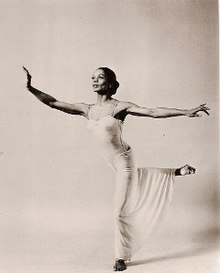Mary Hinkson
This article relies largely or entirely on a single source. (December 2014) |

Mary De Haven Hinkson (March 16, 1925 – November 26, 2014) was an African American dancer and choreographer known for breaking racial boundaries throughout her dance career in both modern and ballet techniques. She is best known for her work as a member of the Martha Graham Dance Company.
Early life/career
Hinkson was born in Philadelphia, Pennsylvania in 1925.[1] Hinkson studied Dalcroze technique in a high school eurythmics class, as well as Native American dance forms at summer camp.[2] However, she did not receive formal dance training until enrolling at the University of Wisconsin, where she studied with Margaret H'Doubler. It was at H'Doubler encouragement that she first saw the Martha Graham Dance Company when they performed in Wisconsin in the 1940s.[2]
In 1951, she was chosen to perform in a demonstration by Martha Graham because of her exceptional talent. This demonstration included works from Dark Meadows, Diversion of Angels, and Sarabande. After this performance, her talents were recognized by Martha Graham and she was asked to join the Martha Graham Dance Company, which was sponsored by the B. de Rothschild Foundation and opened April 13, 1953 at the Alvin Theater. Hinkson was a part of the American Modern Dance Company at the beginning of her career. During her career, Hinkson performed in many pieces. These include Bluebeard's Castle, Clytemnestra, Deaths and Entrances,Cave of the Heart, Ardent Song, Acrobats of God, Phaedra, Canticle for Innocent Comedians, Carmina Burana, The Figure in the Carpet, and Circe. [citation needed]
In 1953, Hinkson achieved the title of principal dancer in Bluebeard’s Castle at the New York City Opera in 1953. Additionally, she was asked to audition for Balanchine's Figure in the Carpet in 1960. Although she was in many productions, she was not able to attend the company's Asian tour in 1956 because of her wedding that year. She and her husband, Julien Jackson and in 1958 had their only child, a daughter, Jennifer. Hinkson' performance in Circe, which opened in London in 1963, was created for her by Graham. [citation needed]
Hinkson also worked with Alvin Ailey and Harry Belafonte. She also taught at Juilliard School of Music, Dance Theatre of Harlem, and the Ailey School. In November 1973, Hinkson had an argument with Graham and ended up leaving the company for good. Though she left the Martha Graham Dance Company at age 48, she continued to be involved with dance by teaching around the world until her retirement. She died of pulmonary fibrosis in Manhattan in 2014, aged 89.[3]
References
- ^ "Mary Hinkson". Notable Black American Women. Biography in Context. Gale. Retrieved May 12, 2014.
- ^ a b Eichenbaum, Rose (2008). The Dancer Within: Intimate Conversations with Great Dancers. Middletown, CT: Wesleyan University Press. p. 65.
- ^ Obituary, nytimes.com, November 30, 2014; accessed December 1, 2014.
Sources
This section lacks ISBNs for the books listed. (December 2014) |
- Allen, Zita. "A Conversation Between Two Dance Legends: Judith Jamison and Mary Hinkson", New York Amsterdam News, February 1, 2007.
- Eichenbaum, Rose, and Aron Hirt-Manheimer (eds.) The Dancer Within: Intimate Conversations with Great Dancers. Middletown, CT: Wesleyan UP (2008).
- Mary Hinkson Dances Way Toward Roadway by Tour", Pittsburgh Courier; accessed July 5, 2013.
- Mary Hinkson profile, ENCYCLOPEDIA OF AFRICAN-AMERICAN CULTURE AND HISTORY. 5 vols. Macmillan, 1996; reprinted by permission of Gale Group.
- "Mary Hinkson in New Ballet Role", Philadelphia Tribune; accessed July 5, 2013.
- "Mary Hinkson Leaves City Opera Company", Philadelphia Tribune; accessed July 5, 2013.
- Tracy, Robert, Goddess: Martha Graham's Dancers Remember. New York: Limelight Editions (1997).
